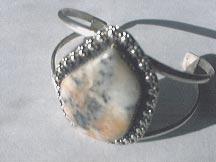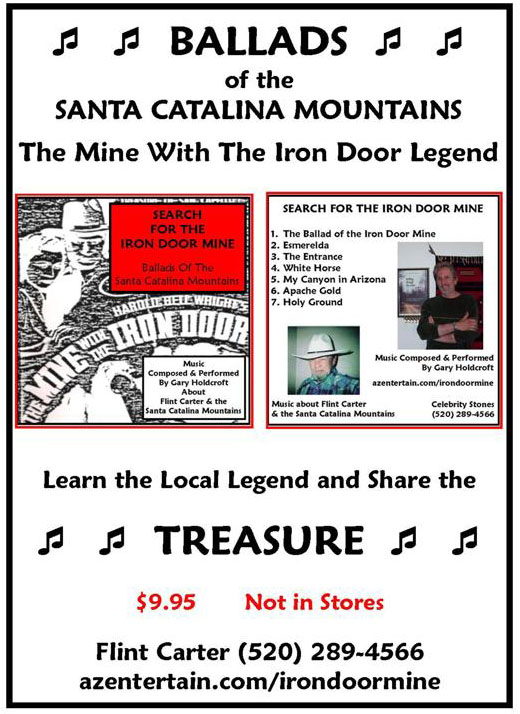AMERICA'S
ANCIENT
TREASURES
Guide to Archeological Sites and Museums
by Franklin Folsom
RAND M9NALLY & COMPANY New York Chicago San Francisco
Copyright MCMLXXI by Franklin Folsom
http://www.archive.org/details/americasancientt002080mbp
The Hohokam Culture
Just as some of the Cochise people ad-
justed to life in the mountains and later
became the Mogollon, so other Cochise
adjusted to life in the desert of southern
Arizona. There they became the Hohokam
(a Pima Indian word for "ancient ones"),
after the knowledge of growing corn and
other plants came to them from Mexico.
Along the Salt, the Gila, and the San
Pedro rivers the Hohokam developed a
special way of life. They dug canals and
diverted water from the rivers to irrigate
their fields far out on the semiarid desert
land. Rich crops resulted from irrigation,
and the River Hohokam not only had
enough to eat, they had time to spare.
Some of them became fine craftsmen,
making lovely jewelry and figurines. The
early Hohokam pottery was buff-colored
with red geometric decorations. Later
potters made decorations in the forms o
ARIZONA STATE MUSEUM
University of Arizona, N. Park Ave. at Third St.,
Tucson. Open free, 10 a.m. to 5 p.m., Monday
through Saturday; 2 p.m. to 5 p.m., Sunday; closed
Jan. 1, July 4, Labor Day, Thanksgiving, Dec, 25.
This remarkable museum has illuminating exhibits
of all major cultures in Southwest prehistory. Dis-
plays include artifacts from; Ventana Cave, which
was occupied by men for almost 10,000 years;
Snaketown, occupied for a long time by the Ho-
hokam people; the Naco and Lehner sites.
The latter site was discovered when a rancher
in the San Pedro Valley saw some large bones ex-
posed in an arroyo. He reported the find to Emil
Haury of the Arizona State Museum. Haury exca-
vated and found evidence that hunters, more than
11,000 years ago, killed nine mammoths and roasted
some of the meat nearby.
An exhibit in the museum shows mammoth bones
and the tools of mammoth hunters exactly as arche-
ologists found them in the earth. Another display
explains how prehistoric men made their stone
tools. Dioramas show a mammoth kill, life around
Ventana Cave 9,000 years ago, people of the Des-
ert culture engaged in food collecting, and later
people at work farming,
The museum also has rich collections of mate-
rials from all the Indian tribes that have lived in
Arizona in historic times.
f
birds or animals or people.
Oracle, AZ mining history- the Old West's Gold Legend
By William "Flint" Carter
Little known, but largely involved,
Oracle, Arizona has been the epicenter for over a century of a literary
and film adventure still alive and growing concerning Gold. Oralce, AZ
is located north of Tucson in the SOuthwest USA.
We all have heard of "The Mine With The Iron Door" legend and most know the film by the same name, which was shot in and near Oracle, AZ.
Most are not aware that the film was re-done four times over six decades. One was "The Secret of Treasure Mountain" in 1955 and "McKennas Gold" in 1968, both were partial re-writes.
From the beginning, the crux of the
epic legend is Gold. There is a saying that Gold does not breed
co-operation and therefore any research will yield outrageous and highly
controversial assumptions.
Joseph Michael has a line in a song
called "Gold Town" which says "Gold still glitters in the ground, hidden
secret, like a laughing clown".
As most can imagine, anything on the
surface is gone, along with the huge galleries mined by large
corporations under growld. For millenniums, mankind has ground and
smelted any rock even thought to contain gold with most deposits now
depleted. Today, the heavy yellow metal approaches $1,000.00 an ounce
compared to $8.00 when the Anglos started coming to the area.
At the Oralce Steakhouse & Lounge, in Oracle, Arizona, is a display of the stones that started the legend. Gold and Silver ores in quartz visible with the naked eye.
The "Cody Stone",
named for Buffalo Bill Cody and from his lost mines near Oracle, is now
in eight museuns world wide and in the National Mining Hall of Fame.
Today in Nevada, 500 tons of ore are
required to produce 1 oz of Gold. Particles so small that they can not
even be seen with a microscope are recovered.
The "Cody Stone" should not be confused with refined gold and silver, as in nature more than one element is present.
For example, Galena = Silver and Lead, Chalcopyrite = Copper Gold.
No two stones are the same and vary
in amounts of gold and silver. However, the stones are extremely rare
and make very attractive pieces of jewelry, preserving our local
Heritage. Very little of the rich deposits remain, but there was a time
when the hills were alive with people delving in the earth for its
treasure. The artist who discovered, produced and is promoting the
stones is W. T. Flint Carter, who has been in the area going on forty
years.
 Historian Flint Carter Historian Flint Carter
About the Artist, Author
William Thomas Carter, "Flint" to his
friends, is an artist and author born in 1947 in Danville, Illinois.
After attending Danville High School, he served in Panama during the
Vietnam conflict at the Latin American Headquarters Post. He received
the National Defense and Good Conduct medals. Returning home, Flint
attended Danville Junior College and later Southern Illinois University.
Special interest in the design department, headed by Buckminster
Fuller, inspired the building of Arizona's first solar heated and cooled
museum. Contact Flint Carter at 520-289-4566.
© 2005-2010 Entertainment Magazine. All rights reserved.
|
|
 Cody
Stone is from Southern Arizona, USA and designed as jewelry grade gold
and silver in quartz. Cody stone specimens and hand made items are on
display at the Oracle Inn Steakhouse & Saloon in Oracle, Arizona.
Call Flint at 520-289-4566 or email finder@emol.org. Mention the Iron Door web site. Cody
Stone is from Southern Arizona, USA and designed as jewelry grade gold
and silver in quartz. Cody stone specimens and hand made items are on
display at the Oracle Inn Steakhouse & Saloon in Oracle, Arizona.
Call Flint at 520-289-4566 or email finder@emol.org. Mention the Iron Door web site.
|

"Ballads of the Santa Catalina Mountains" CD
Listen to songs and ballads on CD
about the Iron Door Mine, the Santa Catalina Mountains, the Old West by
Arizona historian Flint Carter. $9.95. Call 520-289-4566 for more
information and to purchase directly. Mention the Iron Door web site.
Iron Door Mine Legend Tour and Artifacts
Explore displays of over 1,000 Old
West artifacts and specimens from the surrounding area with Flint
Carter. Learn about Western legends. Call Fint at 520-289-4566. Mention
the Iron Door web site.
|
|
"MacKenna's Gold" (1969)
Starring Gregory Peck and Omar Sherif
Attempting to do for
Westerns what his Guns of Navarone had done for World War II action
epics, director J. Lee Thompson crafted Mackenna's Gold as a lavish,
absurdly ambitious variation on Erich Von Stroheim's Greed, resulting in
a last-gasp Western so eager to encompass the genre's traditions that
it turns into a big, silly, wildly entertaining mess. Gregory Peck
surely had more serious intentions when he signed on, and he brings
prestigious gravitas to his glum role as Marshall Mackenna, who gets
shanghaied into searching for the gold-filled canyon of an elusive
Apache legend. The rest of the 1969 film labors to undermine Peck's
respectable demeanor; how else to explain Omar Sharif as a Mexican
villain, Julie Newmar as a hot-blooded Apache temptress (with underwater
nude scenes that were celebrated in Playboy magazine), and a
jaw-dropping finale that's so ridiculous it's impressive in spite of
itself?
Formerly blacklisted screenwriter Carl Foreman and
composer Dimitri Tiomkin joined up to coproduce the film, and one can
only imagine how Anthony Mann or Howard Hawks might've handled Foreman's
sensible script. Thompson goes for scenic splendor, heavy action, and
heavier emotions, casting everything at a fever pitch that's wildly
enjoyable without betraying his "serious" intentions. A stable of
Hollywood veterans (Eli Wallach, Raymond Massey, Edward G. Robinson, and
others) appear in lively supporting roles--they're all dispatched in a
garish Apache ambush--and Camilla Sparv is an ingénue with plenty of
fighting attitude. Gold fever reaches its peak, along with some awesome
special effects, and divine intervention reaches new heights of
intensity. Top it off with José Feliciano's theme song, and you'll be in
zany Western heaven. --Jeff Shannon, Amazon.com
DVD edition of MacKenna's Gold . Studio: Sony Pictures. DVD format. Release Date: July 11, 2000. Run Time: 128 minutes. . Studio: Sony Pictures. DVD format. Release Date: July 11, 2000. Run Time: 128 minutes.
Poster from Mackenna's Gold - Movie Poster -
11 x 17. This poster measures approx. 11 x 17. Rolled and shipped in a
sturdy tube. This poster is from the movie Mackenna's Gold (1969).
Printed book edition of Mackenna's Gold A Five-time Spur Award-winning Author. Somewhere in 100,000 square
miles of wilderness was the fabled Lost Canyon of Gold. With his dying
breath, an ancient Apache warrior entrusted Glen Mackenna with the
location of the lode that would make any man - or woman - rich beyond
their wildest dreams. Halfbreed renegade and captive girl, mercenary
soldier and thieving scout - brave or beaten, innocent or evil, they'd
sell their very souls to possess Mackenna's gold. --This text refers to
the Hardcover edition. Avon Books (Mm) (June 1988).
A Five-time Spur Award-winning Author. Somewhere in 100,000 square
miles of wilderness was the fabled Lost Canyon of Gold. With his dying
breath, an ancient Apache warrior entrusted Glen Mackenna with the
location of the lode that would make any man - or woman - rich beyond
their wildest dreams. Halfbreed renegade and captive girl, mercenary
soldier and thieving scout - brave or beaten, innocent or evil, they'd
sell their very souls to possess Mackenna's gold. --This text refers to
the Hardcover edition. Avon Books (Mm) (June 1988).
Watch video on-demand from Amazon.com of MacKenna's Gold . .
|
|
The Mine with the Iron Door: A Romance (1936)
Movie Poster from the 1936 film The Mine with the Iron Door - Movie Poster - 11 x 17 Poster for the Mine with the Iron Door movie. Stars Richard Arlen,
Ceclia Parker and Henry B. Walthall. Poster measures approx. 11 x 17.
Rolled and shipped in a sturdy tube. This poster is from The Mine with
the Iron Door (1936).
Poster for the Mine with the Iron Door movie. Stars Richard Arlen,
Ceclia Parker and Henry B. Walthall. Poster measures approx. 11 x 17.
Rolled and shipped in a sturdy tube. This poster is from The Mine with
the Iron Door (1936).
Printed Edition of The Mine with the Iron Door.
(The Collected Works of Harold Bell Wright - 18 Volumes) (Library
Binding) Library Binding: 338 pages. Publisher: Classic Publishers,
Language: English. ISBN: 158201891X.
Digital CD Edition of Mine with the Iron Door: A Romance, The (CD-ROM Edition) . The CD-ROM contains 338 pages. Publisher: Classic Books; 1923 edition (December 15, 2007). . The CD-ROM contains 338 pages. Publisher: Classic Books; 1923 edition (December 15, 2007).
|
|